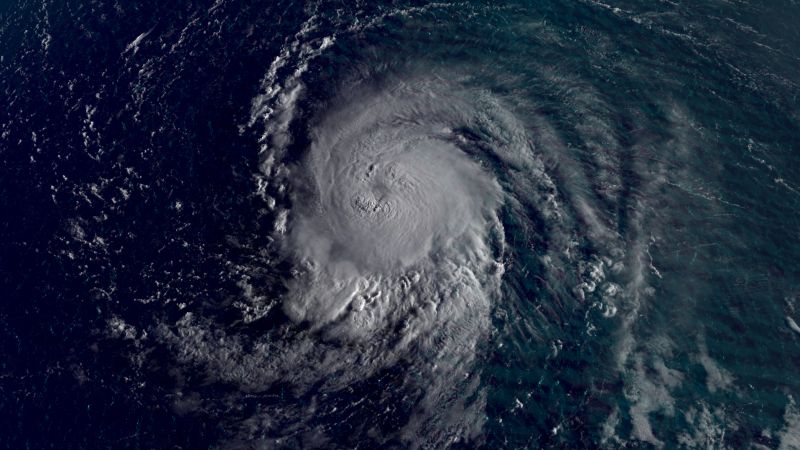Hurricane Lee, the 12th named storm of the Atlantic hurricane season, has arisen as a huge weather event, prompting concerns and warnings from meteorological agencies. As of the most recent updates, Lee is supposed to escalate into an “extremely dangerous” serious storm by Friday, and it represents a possible danger toward the northeast Caribbean, including the Lesser Antilles, the Virgin Islands, and Puerto Rico.

Also Read: Burning Man Exodus Begins after Flooding Trapped Desert
As of the latest updates, Hurricane Lee is situated around 1,815 kilometers east of the northern Leeward Islands in the Atlantic Ocean. It has quickly strengthened and now boasts maximum sustained winds of 120 kilometers per hour (75 miles per hour).
Meteorologists expect further strengthening, with winds projected to reach up to 145 miles per hour (233 kilometers per hour) later this week.
If these projections hold, Hurricane Lee could attain Category 4 status, and in the worst-case scenario, potentially even reach Category 5, making it the most potent hurricane of the year.
The projected way of hurricane Lee involves huge worry for regions in its vicinity. While current forecasts do not indicate a direct landfall on any specific landmass, Lee is anticipated to pass just northeast of the British Virgin Islands.
This direction raises worries for the British Virgin Islands, which are still recovering from the devastation caused by hurricanes Maria and Irma in September 2017.
Also Read: Antarctica: Australia Evacuates Sick Researcher from Outpost
Furthermore, the Leeward Islands, which encompass the Virgin Islands, Anguilla, Saint Martin, and Saint Kitts, have been advised to remain on high alert. While Hurricane Lee’s projected path takes it north of these islands, its close proximity could necessitate the issuance of watches and warnings in the coming days.
One of the most prompt worries related with Hurricane Lee is the potential for life-threatening swells and coastal hazards in the northeast Caribbean. Large ocean swells are expected to propagate towards the Lesser Antilles, the Virgin Islands, and Puerto Rico through the weekend.
These swells can bring about hazardous surf conditions, rip currents, and coastal flooding, posing a severe risk to beachgoers, boaters, and coastal communities.
Specifically, the oceans around Puerto Rico could encounter a huge rise, with projections showing an increment of up to 12 feet (3.7 meters).
Such a surge in ocean levels can prompt immersion of low-lying regions, damaging property and infrastructure, and posing a severe threat to residents in vulnerable coastal zones.
Despite the advances in meteorological forecasting, there remains some uncertainty regarding the precise impacts of Hurricane Lee on the affected regions.
Also Read: Iceland Resumes Whale Hunting under Strict Rules
A few elements add to this vulnerability, including the hurricane’s track, intensity, and interactions with atmospheric conditions. As of now, the primary concern is focused on coastal hazards and the potential for significant wave action, but the exact extent of rainfall and wind impacts remains unclear.
The National Weather Service in San Juan has noted this uncertainty, highlighting that Lee is forecasted to pass a few hundred miles north of the islands. While this might lessen the probability of an immediate hit, it is essential to stay watchful and ready, as tropical storm tracks can develop.
Hurricane Lee’s rise as a strong storm comes surprisingly close to the 2023 Atlantic hurricane season. This season has been eminent for its above-average activity, as predicted by the National Ocean and Atmospheric Administration (NOAA) in August.
The agency forecasted an increased likelihood of an above-normal number of named storms, hurricanes, and major hurricanes.
Specifically, NOAA’s projections indicated between 14 to 21 named storms for the season, with the potential for six to 11 hurricanes and two to five major hurricanes.
Hurricane Lee’s rapid intensification underscores the unpredictability and potency of these storms, making hurricane preparedness and response efforts all the more critical for coastal communities.
Also Read: Rare Blue Supermoon Lights Up Skies Around the World
Top Sources Related to Dangerous Hurricane Lee Forecast to Become Category 5 (For R&D)
CNN News:
CBS News:
Sources Related to Floods in Last 3 Months Around the World (For R&D)
- China floods: Xi Jinping urges action as rains kill 15 and displace thousands
- At Least 1 Dead as Heavy Rains Set Off Flash Flooding in New York
- Mongolia – Floods
- Assam Floods: About 18,000 People Suffer From Terrible Flood In Dhemaji District
- At least 50 dead in Pakistan monsoon floods since end of June
- New Delhi Floods: Deadly Monsoon Rains, leaving 15 Dead
- Japan Floods: Heavy Rains Causes Floods and Landslides, 1 Dead
- South Korea Floods: At Least 26 Dead and Over 1000 Evacuated
- Central Russia:10 Dead, Including 3 Children as Strong Winds hit Tourist Camp
- Typhoon Doksuri: Beijing’s Heaviest Rain in a Decade Kills at Least 11
- Slovenia Floods: At least 2 Dead, Forcing Evacuations
- Georgia: 11 Killed in Landslide at Mountain Resort Town of Shovi
- Alaska: Houses Swept Away by Glacial Floods in Juneau
- Nepal: At Least 38 Killed, Several Missing in Floods And Landslides
- China: 21 Killed, 6 Missing After Mudslide in Xi’an
- Hurricane Hilary hits California after Lashing Mexico
- Pakistan: Floods Force Evacuation of Almost 100,000 People
- Himachal Pradesh Landslide: 8 buildings Collapsed in Kullu
- Hurricane Idalia Makes Landfall in Florida and Georgia
- Typhoon Saola Threatens China with Category 4 Winds
- Typhoon Haikui: More than 4,000 People were Evacuated
- Brazil Cyclone Kills At Least 31 and Leaves Over 1,600 Homeless





